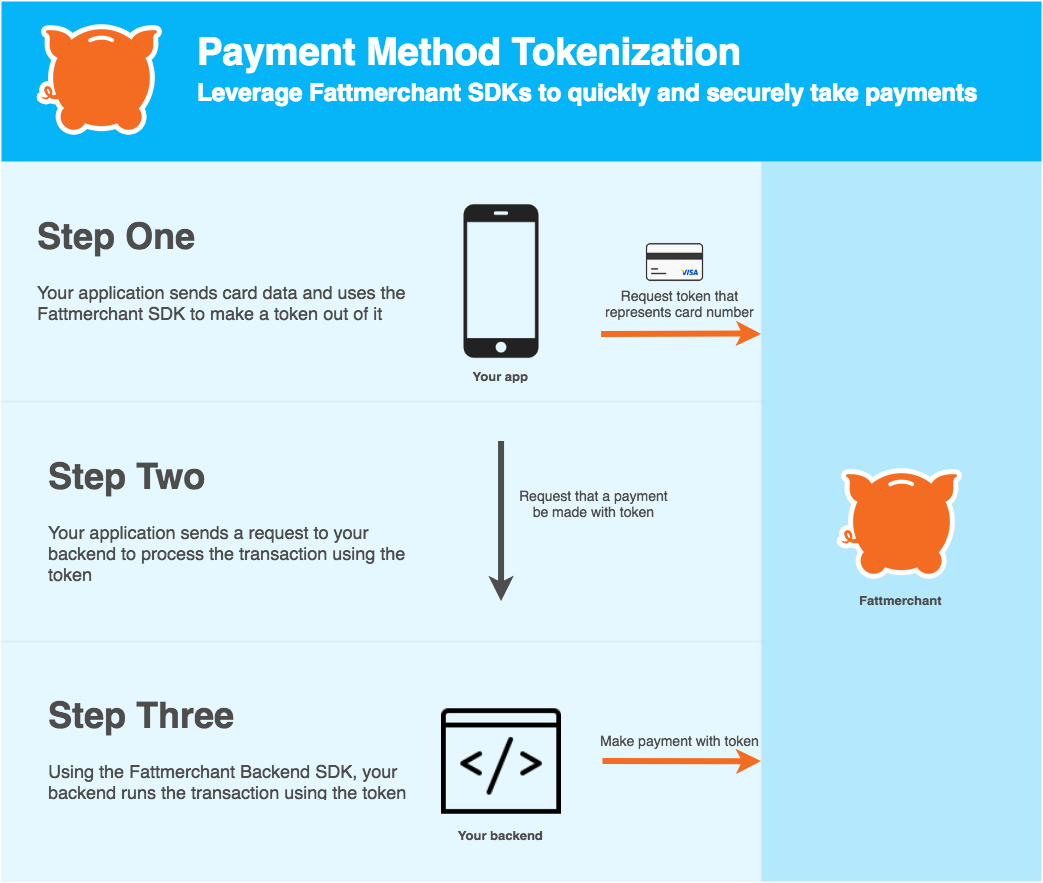The Fattmerchant iOS SDK provides a simple way to accept a payment on your iOS app by providing tokenization of payment methods. By using these tokens instead of card and bank information, you no longer have to worry about sending sensitive card information to your server.
The Fattmerchant iOS SDK comes with a Swift Playground. All you need to get started is your web payments token, provided to you by your trusty Fattmerchant Account Manager. You can find the playground, called Tokenization.Playground in the project root 🤓
- Xcode 8
- iOS 9
Use CocoaPods to install the Fattmerchant iOS SDK.
- Install CocoaPods
- Add
pod 'Fattmerchant'to yourPodfile - Run
pod install
To accept a payment, you'll need to collect information from the customer, tokenize it, and send the token to your server. Your server will then be responsible for using the Fattmerchant API to run the transaction.
You'll first need to setup the FattmerchantApi for usage. All you have to do here is set the webPaymentsToken field on the shared FattmerchantConfiguration. FattmerchantApi will then use that configuration by default.
import UIKit
import Fattmerchant
@UIApplicationMain
class AppDelegate: UIResponder, UIApplicationDelegate {
func application(_ application: UIApplication, didFinishLaunchingWithOptions launchOptions: [UIApplicationLaunchOptionsKey: Any]?) -> Bool {
FattmerchantConfiguration.shared.webPaymentsToken = "mywebpaymentstoken"
// ...
return true
}
}Alternatively, you may create a configuration object and pass it to the new FattmerchantApi instance as you need it.
let configuration = FattmerchantConfiguration(webPaymentsToken: "mywebpaymentstoken")
let fattClient = FattmerchantApi(configuration: configuration)You first want to collect credit card information and populate a CreditCard or a BankAccount object.
let card = CreditCard(personName: "Joan Parsnip",
cardNumber: "4111111111111111",
cardExp: "1220",
addressZip: "32814")
// Or for a bank account...
let bankAccount = BankAccount(routingNumber: "021000021",
accountNumber: "38294738291937485",
bankHolderType: .personal,
accountType: .checking)If you want to associate a Customer with the new PaymentMethod, all you have to do is pass is set the customerId on the CreditCard or BankAccount
let card = CreditCard(personName: "Joan Parsnip",
cardNumber: "4111111111111111",
cardExp: "1220",
addressZip: "32814",
customerId: "7404cae1-86ba-408c-bb43-8c5cacfdcaab")Once you have a CreditCard object, call the tokenize(:) method on FattmerchantAPI object and pass a block to run once tokenization is complete.
let fattClient = FattmerchantApi(webPaymentsToken: "mywebpaymentstoken")
fattClient.tokenize(card) { (response) in
if case let .success(paymentMethod) = response {
let paymentToken = paymentMethod.id
print("I must now use \(paymentToken) to create a payment.")
}
// Success! You can now run a transaction with Fattmerchant using paymentToken as the PaymentMethod
}Or you can set a delegate to be notified.
class MyClass: FattmerchantApiDelegate {
func gottaHaveThatFunc() {
// ...
let fattClient = FattmerchantApi(webPaymentsToken: "mywebpaymentstoken")
fattClient.delegate = self
fattClient.tokenize(card)
}
func fattmerchantApi(_ fattmerchantApi: FattmerchantApi, didCreatePaymentMethod paymentMethod: PaymentMethod) {
let paymentToken = paymentMethod.token
// You can now run a transaction with Fattmerchant using paymentToken as the PaymentMethod
}
func fattmerchantApi(_ fattmerchantApi: FattmerchantApi, didReceiveError: Error) {
if case let .tokenizationError(errors) = error {
print("Uh oh! 😡 We got errors!")
errors.forEach { print($0) }
}
}
}Now that you have the token representing the payment method, you can send it to your server to run a payment with it. You have to setup a way for your backend to accept the token and create a transaction with it.
If you'd like to try tokenization without real payment information, you can use the CreditCard.testCreditCard() or BankAccount.testBankAccount() methods to get a test credit card or bank account.
let creditCard = CreditCard.testCreditCard()
let bankAccount = BankAccount.testBankAccount()If you want to test failures, you can use the following methods
let failingCreditCard = CreditCard.failingTestCreditCard()
let failingBankAccount = BankAccount.failingTestBankAccount()Or you can create the CreditCard or BankAccount object with the following testing payment information:
| Card Type | Good Card | Bad Card |
|---|---|---|
| VISA | 4111111111111111 | 4012888888881881 |
| Mastercard | 5555555555554444 | 5105105105105100 |
| Amex | 378282246310005 | 371449635398431 |
| Discover | 6011111111111117 | 6011000990139424 |
| JCB | 3569990010030400 | 3528327757705979 |
| Diners Club | 30569309025904 | 30207712915383 |
Use any CVV number for the above
- Routing: 021000021
- Account: 9876543210
To test failing bank accounts, use the given routing number and any other account number
